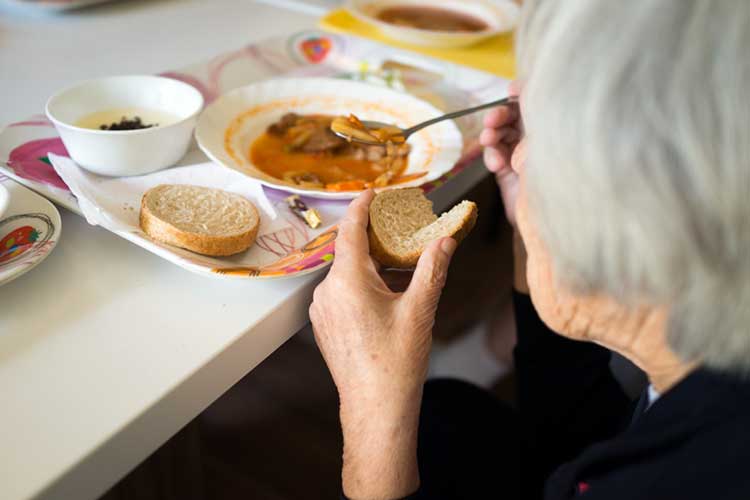Requiring assistance to eat daily meals puts clients in a vulnerable position. A great deal of tact and constant communication are needed from the staff providing this care.
There are steps you can take to make a client’s mealtime as dignified and as seamless as possible.
It’s estimated that 15% of clients receiving home care are malnourished (TAS DoH 2020).
One simple way to increase the likelihood of a client receiving the nutrition they need is to play an active role in their mealtime. In doing this, you are able to observe that:
- The meal is properly cooked and prepared
- The client is finishing the meals.
This article will outline methods of providing effective meal assistance in home care.
Reasons for Needing Assistance During Meal Time
Health complications that may affect a client’s ability to eat and drink independently include:
- Dementia or impaired cognition
- Weakness in hands or fingers due to joint pain (e.g. arthritis)
- Poor or restricted vision
- Swallowing difficulties
- Weakness or fatigue
- Other physical or cognitive impediments.
(Eat Well Nutrition 2020)
Types of Assistance

The level of assistance required by clients will vary.
This can range from:
- Supervision, prompting and encouragement
- Setting up cutlery
- Cutting up meals
- Full feeding assistance.
(Eat Well Nutrition 2020)
Before the Meal
- It may seem obvious, but check that the meal is correct for the client.
- Ensure the meal has been heated well and is the right consistency.
- Check that tables and trays are set up to suit the client and that appropriate utensils are available. Adjust these as necessary.
- Ensure that the client has all the aids they require for mealtime, for example, dentures and glasses.
(Aged Care Guide 2014; Eat Well Nutrition 2020)
During the Meal
Communication
- Talk to the client about the meal they’re about to eat. It’s particularly important to explain what the food is when the meal has been puréed or texture-modified to facilitate chewing/swallowing/digestion.
- Ask the client if they would like a cloth or clothing protector, altered utensils or any other item that would make them feel more comfortable during mealtime.
- Ask the client if there is something particular on the plate they would like to eat.
- Always let the client know what you are doing and identify what the food is before serving it to them.
- Make conversation with the resident if appropriate.
- Do everything you can to make mealtime an enjoyable experience, and remember that it may be a high point in the client’s day.
(Aged Care Guide 2014; Health.vic 2024; ACQSC 2024)
Physical Assistance
- The first step is to ensure that the client is sitting comfortably upright and is within easy reach of their meal.
- Sit with the client, making sure you are at their eye level and ready to assist if needed. Once they have seen the meal as it is intended to look, cut it up in front of them. Resist mixing the food together and await the client’s instructions instead.
- Ensure the spoon is at the client’s eye level and give them enough time to open their mouth.
- Demonstrate responsiveness to cues from the client, such as knowing when to bring their plate closer toward them, when they are ready for the next mouthful or when they need a break.
- Serve the client as you would yourself, including different elements of the dish. Always have water nearby to aid food intake.
(Aged Care Guide 2014; Health.vic 2024)
After the Meal
Immediately after the meal is finished, check the client’s appearance and surroundings. For example, help remove any crumbs on their face or clothing (Elderly Health Service 2025).
Make an appropriate closing remark at the end of the meal - do not simply pack up and leave without saying anything (Health.vic 2024).
If you’ve noticed that the client is not eating or drinking enough on a regular basis, communicate this to their family and relevant supervisors and document appropriately, such as in their care plan (Aged Care Guide 2014).
Before escalating the issue, try to find out if there’s a simpler reason why they’re not eating, for example, if the food isn’t to their liking or if they would rather eat at a different time of day (Eat Well Nutrition 2014).
Be Tactful
Imagine yourself in the client’s place and approach meal assistance with sensitivity. Bear in mind that while a person may need significant help at mealtime, there is a difference between being helpful and undermining a person’s independence. Remember that your role is to share the mealtime experience with the client and allow them to dine with dignity (Aged Care Guide 2014).

Test Your Knowledge
Question 1 of 3
Which one of the following behaviours is cause for concern?
Topics
Further your knowledge
References
- Aged Care Guide 2014, ‘Dignity in the Dining Room’, Aged Care Guide, 24 February, viewed 8 August 2025, https://www.agedcareguide.com.au/talking-aged-care/dignity-in-the-dining-room
- Aged Care Quality and Safety Commission 2024, Dining in Residential Aged Care – Tips, Tricks and What to Avoid, Australian Government, viewed 8 August 2025, https://www.agedcarequality.gov.au/resource-library/dining-residential-aged-care-tips-and-tricks-fact-sheet
- Eat Well Nutrition 2020, Mealtime Assistance, Eat Well Nutrition, viewed 8 August 2025, https://www.eatwellnutrition.com.au/preventing-malnutrition/mealtime-assistance
- Elderly Health Service 2025, Feeding Skills for Carers of Frail Elderly, The Government of the Hong Kong Special Administrative Region, viewed 8 August 2025, https://www.elderly.gov.hk/english/carers_corner/caring_skills/feeding.html
- Health.vic 2024, Assisted Eating, Victoria State Government, viewed 8 August 2025, https://www2.health.vic.gov.au/ageing-and-aged-care/dementia-friendly-environments/strategies-checklists-tools/eating-assisted
- Tasmania Department of Health 2020, Malnutrition, Tasmanian Government, viewed 8 August 2025, https://www.health.tas.gov.au/sites/default/files/2021-11/Malnutrition_factsheet_DoHTasmania2020.pdf
 New
New 

